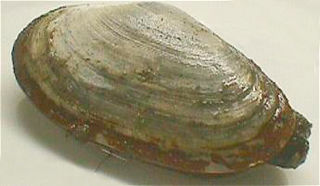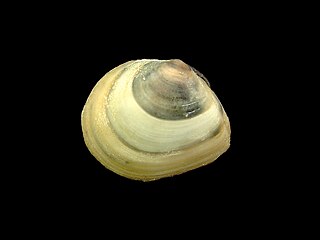
Clam is a common name for several kinds of bivalve molluscs. The word is often applied only to those that are edible and live as infauna, spending most of their lives halfway buried in the sand of the seafloor or riverbeds. Clams have two shells of equal size connected by two adductor muscles and have a powerful burrowing foot. They live in both freshwater and marine environments; in salt water they prefer to burrow down into the mud and the turbidity of the water required varies with species and location; the greatest diversity of these is in North America.

Mya is a genus of saltwater clams, marine bivalve molluscs in the family Myidae. They are widespread and abundant in northern waters. Commonly known as Ipswich clams, soft-shell clam or steamers, they are routinely used as a food source for humans.

The Atlantic surf clam, also called the bar clam, hen clam, skimmer or simply sea clam, is a very large, edible, saltwater clam or marine bivalve mollusk in the family Mactridae. It is commonly found in the western Atlantic Ocean. Reaching up to 20 centimetres (7.9 in) or more in length, it is much larger than Spisula solida, which resides in the eastern Atlantic coastal waters.

Limecola balthica, commonly called the Baltic macoma, Baltic clam or Baltic tellin, is a small saltwater clam, a marine bivalve mollusk in the family Tellinidae.

Lajonkairia lajonkairii is an edible species of saltwater clam in the family Veneridae, the Venus clams.

Mya truncata, common name the blunt gaper or truncate softshell, is a species of edible saltwater clam, a marine bivalve mollusk in the family Myidae.

Austrovenus stutchburyi, common name the New Zealand cockle or New Zealand little neck clam, is an edible saltwater clam, a marine bivalve mollusc in the family Veneridae, the Venus clams. Its Māori name is tuangi or tuaki.

Steamed clams is a seafood dish consisting of clams cooked by steaming.
M. arenaria may refer to:

Cyrtopleura costata, or the angel wing clam, is a bivalve mollusc in the family Pholadidae. It is found in shallow parts of the northwest Atlantic and also in the North Sea of Scotland coastline and west coast of the Adriatic Sea by a remote area in the Marche region in central Italy, living in the seabed, where it digs its burrows on a very slow revolving movement for years through soft sand and mud always to a max depth of 8ft but always below 3 feet (0.91 m) at the lowest tide.

Mulinia lateralis, the dwarf surf clam or coot clam, is a species of small saltwater clam, a bivalve mollusc in the family Mactridae. It occurs in the western Atlantic Ocean and the Caribbean Sea.
Laternula elliptica is a species of saltwater clam, a marine bivalve mollusc in the family Laternulidae, the lantern shells. It is the largest bivalve found under the surface of the seabed in the Southern Ocean.

Anadara kagoshimensis is an ark clam in the family Arcidae. It can be found in shallow water in temperate parts of the west Pacific Ocean and is cultivated in China, Japan, and Korea for human consumption. It is known as maohan in China and mogai in Japan.

Saxidomus gigantea is a large, edible saltwater clam, a marine bivalve mollusk in the family Veneridae, the venus clams. It can be found along the western coast of North America, ranging from the Aleutian Islands to San Francisco Bay. Common names for this clam include butter clam, Washington clam, smooth Washington clam and money shell.
Potamocorbula amurensis is a species of small saltwater clam, a marine bivalve mollusc in the order Myida. Common names include the overbite clam, the Asian clam, the Amur River clam and the brackish-water corbula. The species is native to marine and brackish waters in the northern Pacific Ocean, its range extending from Siberia to China, Korea and Japan. It has become naturalised in San Francisco Bay.

Macoma tenta, the narrowed macoma clam or elongate macoma is a species of clam, a marine bivalve mollusk (bivalvia) in the family Tellinidae and genus Macoma. Macoma tenta are one of two species of macoma clams that can be found in the Chesapeake Bay on the eastern shore of the United States in Maryland and Virginia. The macoma tenta like their cousin in the Chesapeake, the Macoma balthica or Baltic macoma clam, are small marine bivalves with thin, chalky white shells. They tend to live buried in the sandy or muddy areas of shallow water in the middle and lower Chesapeake Bay. Macoma clams are among the most abundant clams in the Chesapeake Bay. Macomas first appeared about 750,000 years ago.

Solecurtus strigilatus, also known as the rosy razor clam, is a species of saltwater clam, a marine bivalve mollusc in the family Solecurtidae. This mollusc is a suspension feeder and can burrow with great rapidity to escape predators. It is an unusual bivalve in that its shell valves are too small to contain all the soft tissue, and the animal is unable to retreat into its shell.

Cerebratulus lacteus, the milky nemertean or milky ribbon worm, is a proboscis worm in the family Lineidae. This ribbon worm has a wide geographical range on both sides of the northern Atlantic Ocean.

Panopea bitruncata is a species of marine bivalve commonly known as the Atlantic geoduck or Atlantic geoduck clam. These clams like their more famous Pacific relative P. generosa have an enlarged siphon that can extend to great lengths or contract to just barely poke out of the shell. They are generally smaller in comparison to the Pacific species though still constitute a sizable mollusc as they cannot fully retract their siphon.





















